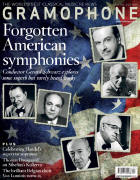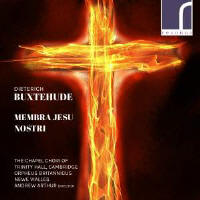Texte paru dans: / Appeared in:
|
|||||||
|
Outil de traduction (Très approximatif) |
|||||||
|
Reviewer: Marc Rochester Little is known about the origins of Buxtehude’s Membra Jesu nostri. It is cast as a cycle of seven cantatas reflecting on, in ascending sequence from feet to face, seven different body parts of Christ as a focus for a contemplation of Christ’s suffering on the Cross. It stands as a unique and special work in the composer’s output of sacred vocal music, not least because it is not part of any Lutheran liturgy; and in using a Latin text it seems that Buxtehude was not writing the work for a specific ecclesiastical performance but as something to be pored over and inspected by a circle of scholars. That idea is reinforced by the unusual level of imagination and originality in its construction, as well as in Buxtehude’s often ingenious responses to the text. While it may be that individual cantatas were originally performed in isolation, there is an unarguable logic in presenting all seven in a continuous sequence, which is how most of us today know the work. By my reckoning there are at least two dozen recordings currently available, most of which are highly impressive… Even so, each of these new recordings offers something individual which makes them enticing on their own terms. The weightiest comes from Benoît Haller, La Chapelle Rhénane and La Maîtrise de Garçons de Colmar, where, with boys’ voices on the top line and hefty instrumental support, the overall effect is more choral society than period performance. Certainly this very full sound brings out the drama of the work; and with six powerful, almost operatic soloists, the performance has a breadth and expansiveness that is well captured by the full-blooded engineering. At times, this performance does come dangerously close to being bogged down by the sheer weight of numbers, and I find the sixth cantata (‘To the Heart’) possibly a little too robust and operatic to be wholly convincing as an intense devotion to the dying Christ. The fifth cantata (‘To the Breast’) does, however, burst into life with a glorious explosion of energy and some superbly detailed singing from the three male soloists. Supplementing the same vocal and instrumental forces he used on his 2017 Priory disc devoted to the sacred music of Purcell with the newly formed period-instrument ensemble Newe Vialles, Andrew Arthur has also assembled a substantial body of performers. Yet he uses them most effectively, drawing from them an intimacy and directness of expression which gets right to the core of the work. Interpretatively, the most impressive thing is Arthur’s pacing and sense of deep repose. Time seems to stand still with the orchestral Sonata which opens the fourth cantata (‘To the Side’) before gently moving on into a decidedly Monteverdian setting of a text derived from the Song of Solomon. At no time do you feel that Andrew Arthur is in any sort of a hurry to get through the work, and a sense that at every corner and turn he is content to linger contemplatively imbues this performance with a rare sense of ease. Excellent as both these recordings are, they are somewhat eclipsed by the third, from Philippe Pierlot and the Ricercar Consort. While Haller drew on the services of a large chorus, six soloists and an instrumental ensemble of some dozen players, and Arthur used 29 voices and an instrumental ensemble of 10, Pierlot makes do with just five singers and nine instrumentalists. That, though, is no recipe for thin and desiccated sound. Instead what we have here is a wonderfully full yet transparent sound, greatly enhanced by the sheer quality of the voices, and recorded with such luxuriance that the only concessions to the thinner forces are greater flexibility and a sense of a more focused expressive intent. This is a truly lovely recording which certainly lacks neither the drama nor the intimacy of the others, but adds to it a clarity of thought and expressive detail that I find wholly absorbing. Unique among these latest recordings of Membra Jesu nostri, Pierlot adds a useful filler in the shape of Buxtehude’s unequivocally Lutheran chorale-based cantata Gott, hilf mir!. This pales only slightly in comparison with Membra Jesu nostri, and with Matthias Vieweg in fine voice and the violins of the Ricercar Consort vividly evoking his terror at being stuck in mud with the tide rushing in, this is no mere makeweight to fill 10 spare minutes but a highly distinguished performance that caps a highly distinguished disc. |
|||||||






